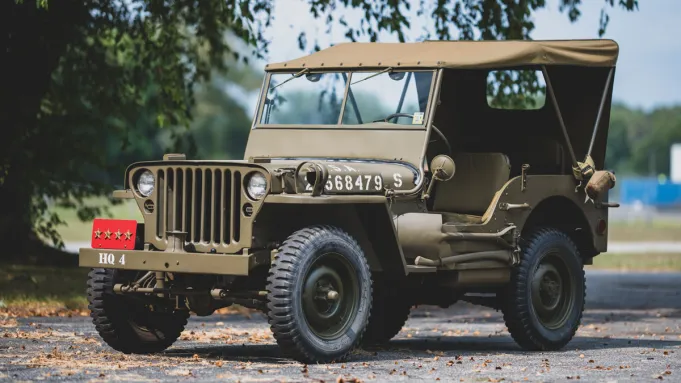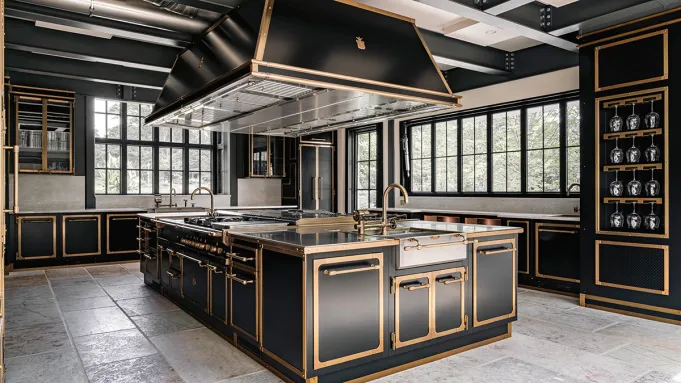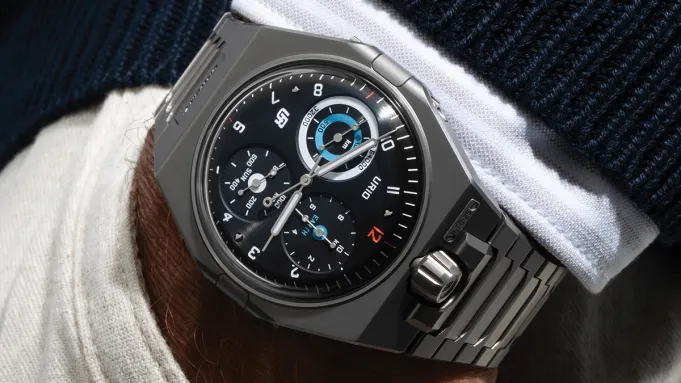
It’s not a sports car, and it won’t win any beauty contests, but the Willys MB (also known later as the Willys Jeep) did help win World War II. Even well into the 1930s, America’s defense machinery was woefully lacking, especially in the critical transport of material and personnel. Astonishingly, the most capable machine for moving supplies and equipment—the same as that used during World War I and the 19th century—wasn’t a machine at all, but a mule. As the Axis juggernaut threatened Europe and the rest of the world, it was obvious that an equine infantry could not serve the needs of the European theater and beyond. And so, the Jeep, one of the most significant vehicles of all time, was born.

This 1945 Willys Jeep sold for $44,800 through RM Sotheby’s in 2020.
Darin Schnabel, courtesy of RM Sotheby’s.
While American Bantam is generally credited with the original Jeep, it was Ford and Willys–Overland, an Ohio-based manufacturer founded in 1908 and which merged with Kaiser Jeep in 1953, who bid on the government contract to develop a mass-produced lightweight reconnaissance vehicle based on the Bantam design. The first Willys MB was built in 1941, and when people think of Jeep, it’s the Willys version that comes to mind: a mechanical mule that was seemingly the price of a good lawnmower, and far less sophisticated.
The origin of the name “Jeep” is not entirely clear, but Eugene the Jeep, a curious quadruped in the Popeye comics, popularized the name, for which Willys-Overland finally gained patent rights in 1950 after years of battling with the U.S. Patent Office.

The interior defines minimalist, utilitarian functionality like no other.
Darin Schnabel, courtesy of RM Sotheby’s.
Following the war’s end, the Willys CJ-2A—essentially a military MB model (sans artillery)—became the company’s mainstay and the first mass-produced civilian vehicle equipped with four-wheel drive. Ideal for farms and unimproved roads in rural communities, it was powered by a 60 hp, 2.2-liter inline-four engine paired with a three-speed manual transmission.
Notably, early models featured fanciful color combinations right at home on the farm, such as Pasture Green with Autumn Yellow wheels and Harvest Tan with Sunset Red wheels. About 215,000 examples were built from 1945 through 1949. The CJ-3A followed through 1953, replaced by the CJ-3B until 1968. The CJ-5, with more than 600,000 built from 1954 through 1983, is the most common of the old-time Jeeps, along with its successor, the CJ-7. Much as with penguins, it takes a seasoned Jeep-spotter to distinguish one model from another.

The inline-four engine is mated to a three-speed manual transmission.
Darin Schnabel, courtesy of RM Sotheby’s.
A lot has happened to the Jeep since American soldiers planted a flag on Iwo Jima, but after 80 years, the family resemblance of today’s Jeep Wrangler to the original is still readily apparent, though contemporary models are thoroughly modern cars. Their rugged endurance is what endears Jeeps to car-lovers with a sense of history and who appreciate the significance of a vehicle that defined an indefatigable generation. In today’s world, the Jeep remains an authentic and unpretentious outlier.

Following the end of World War II, the Willys Jeep proved ideal for use on farms and for transport in rural communities with unimproved roads.
Darin Schnabel, courtesy of RM Sotheby’s.
A Willys CJ-2A is a fun addition to any collector’s garage, and enthusiasts who fancy a first restoration project couldn’t do much better than rebuilding a vehicle as simple as a washing machine, with reproduction parts readily available from companies like Willys-Overland Motors. Alternately, a “concours-ready” CJ-2A can top $30,000, with an example in good condition at less than half that amount. Military-history buffs who want a World War II–era Willys MB might pay $25,000 for one in good condition, and more than $40,000 for a pristine, parade-ready example.
Click here for more photos of this 1945 Willys Jeep.
Authors
-

Robert Ross
Automotive editorial consultant Robert Ross began his publishing career in 1989, and has worked with Robb Report from 2001 to present writing about art, design, audio and especially cars—new and old…
instagram:
Error: No feed with the ID 1 found.
Please go to the Instagram Feed settings page to create a feed.










